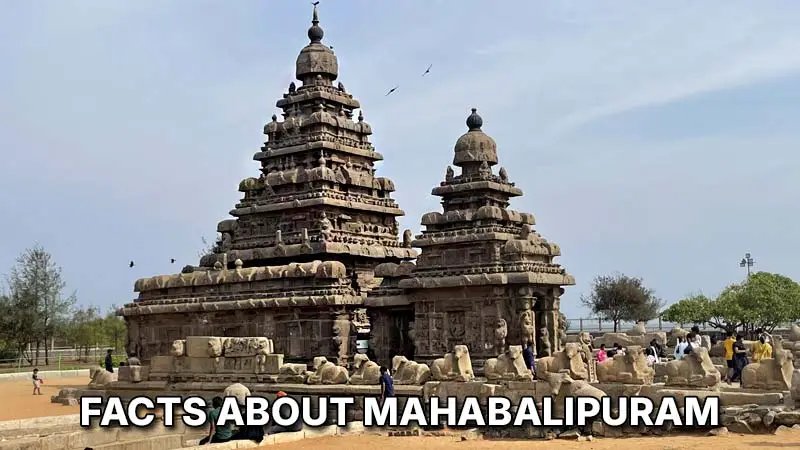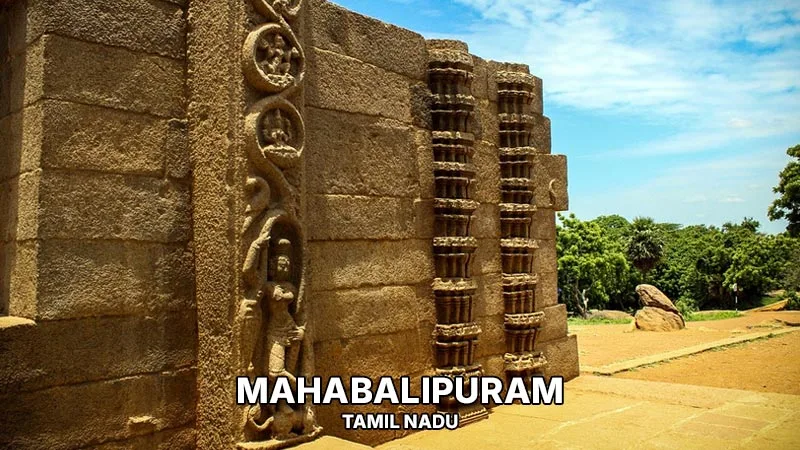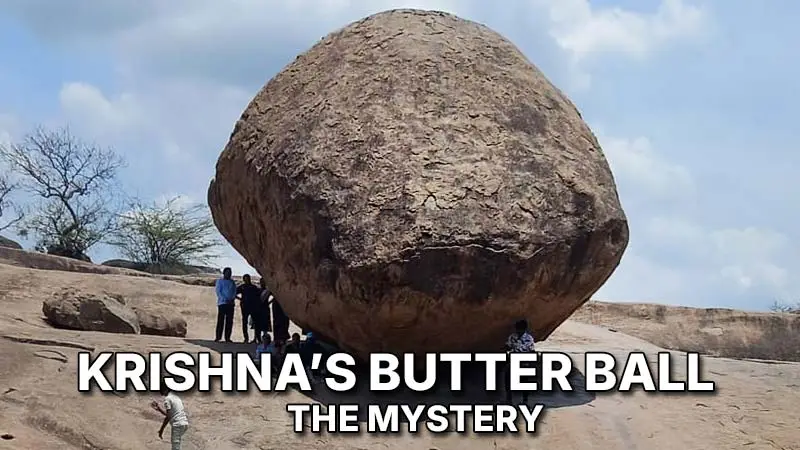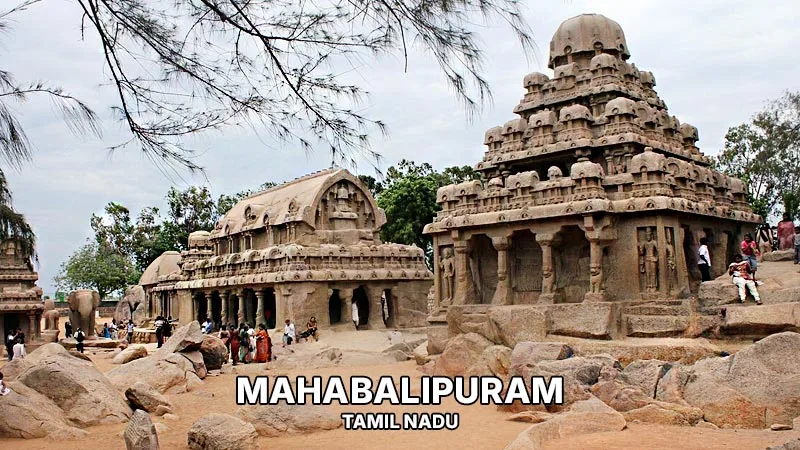Mahabalipuram, or Mamallapuram as locals call it, is one of those rare places where history feels alive. This coastal town in Tamil Nadu is full of ancient monuments, stunning stone carvings, and stories that have survived centuries.
During my time exploring Mahabalipuram, I realized that every rock and temple here seems to whisper secrets from the past.
Here are 10 fascinating facts about Mahabalipuram that everyone should know, followed by 20 more lesser-known but equally captivating details I discovered.
Contents
- 10 Interesting Facts About Mahabalipuram
- 1. The Mystery of the Seven Pagodas
- 2. Ancient Tsunami Evidence
- 3. A Canvas of Continuous Carving
- 4. Hidden Caves Yet to Be Found
- 5. Arjuna’s Penance: The World’s Largest Open-Air Bas-Relief
- 6. Krishna’s Butterball – Defying Gravity
- 7. Solar Alignment at the Shore Temple
- 8. Sculptures With Buddhist Influences
- 9. A Port City That Shaped History
- 10. Tiger Cave’s Unfinished Beauty
- 20 Additional Amazing Facts About Mahabalipuram
- 11. British Officers Failed to Move Krishna’s Butterball
- 12. Southeast Asian Artistic Links
- 13. Two Lighthouses, Two Time Periods
- 14. Sacred Temple Water Tanks
- 15. The Town’s Original Name Was Mamallapuram
- 16. A UNESCO World Heritage Site Since 1984
- 17. Local Sculptors Keep Ancient Traditions Alive
- 18. Shore Temple Faces the Ocean Boldly
- 19. Ancient Drainage Systems
- 20. Mahabalipuram’s Dance Festival
- 21. Underwater Ruins Found by Divers
- 22. Nandi Statue Stands Guard
- 23. Temples Symbolizing Elements
- 24. Mahabalipuram Survived Centuries of Cyclones
- 25. Arjuna’s Penance is Also the World’s Largest Sculptural Frieze
- 26. The Tiger Cave Might Be an Unfinished Theatre
- 27. British Era Additions
- 28. Stone Elephants Look Almost Alive
- 29. A Place Where History Meets the Sea
- 30. Mahabalipuram Inspired Legends of Atlantis
10 Interesting Facts About Mahabalipuram
1. The Mystery of the Seven Pagodas
Mahabalipuram was once known as the “City of Seven Pagodas.”
Today, only the Shore Temple remains visible while the other six are believed to have sunk beneath the sea. Standing on the beach and gazing at the horizon, I couldn’t help but imagine the majestic sight of seven temple spires rising from the waves centuries ago.
2. Ancient Tsunami Evidence
Locals talk about a tsunami long before the one in 2004 that may have washed away parts of Mahabalipuram. When I heard this, I found myself wondering how many stories were lost forever under the ocean’s surface.
3. A Canvas of Continuous Carving
The monuments here weren’t made in one go. They were crafted over 400 years, with each Pallava king adding his own touch. As I walked past sculptures, I tried to spot these subtle differences—it felt like flipping through pages of history carved in stone.
4. Hidden Caves Yet to Be Found
It’s said that there are still caves around Mahabalipuram waiting to be discovered. That thought made every hillock and rocky slope seem like an invitation to explore further.
5. Arjuna’s Penance: The World’s Largest Open-Air Bas-Relief
This masterpiece is 29 meters long and 13 meters high, depicting gods, animals, and celestial beings. I stood there for ages, mesmerized, tracing the details with my eyes. It felt like the entire granite face was alive with stories.
6. Krishna’s Butterball – Defying Gravity
This giant boulder rests on a slope and has stayed put for over 1,200 years. Even elephants couldn’t move it when the British tried in 1908. Standing beneath it, I felt a mix of awe and nervous excitement as if it might roll any second, though locals assured me it never would.
7. Solar Alignment at the Shore Temple
The Shore Temple was designed to catch the first rays of sunrise and the last light of sunset. Watching the morning sun light up the ancient stones felt magical, like the architects planned this moment for visitors centuries later.
8. Sculptures With Buddhist Influences
Some carvings here resemble Buddhist art styles. I loved noticing these subtle details—it made me realize how open this ancient town was to cultural exchanges.
9. A Port City That Shaped History
Centuries ago, Mahabalipuram was a busy port trading with Southeast Asia. I tried to imagine ships docking here with treasures and stories from distant lands.
10. Tiger Cave’s Unfinished Beauty
Tiger Cave, just outside town, features carvings of lions around a semicircular stage. No one knows why it was left incomplete, but as I sat there, I felt the place still carries the energy of performances that never happened.
20 Additional Amazing Facts About Mahabalipuram
11. British Officers Failed to Move Krishna’s Butterball
The 1908 elephant attempt wasn’t the only one—locals say even kings tried centuries earlier, but the rock refused to budge.
12. Southeast Asian Artistic Links
Carvings here resemble those in Cambodia and Java, proving Mahabalipuram’s influence extended far beyond India.
13. Two Lighthouses, Two Time Periods
Next to a Pallava-era lighthouse stands a British-built one, a reminder of how Mahabalipuram continued guiding travelers across centuries.
14. Sacred Temple Water Tanks
Many temples here have water tanks carved into stone for rituals. I found their design as impressive as the monuments themselves.
15. The Town’s Original Name Was Mamallapuram
Named after King Narasimhavarman I (Mamalla means “great wrestler”), the name reflects the king’s strength and cultural impact.
16. A UNESCO World Heritage Site Since 1984
Mahabalipuram earned its World Heritage status for its unique architecture and preservation.
17. Local Sculptors Keep Ancient Traditions Alive
Walking through town, I heard the rhythmic sound of chisels. The descendants of Pallava sculptors still carve stone statues today.
18. Shore Temple Faces the Ocean Boldly
Unlike most Indian temples, it faces the sea directly, enduring centuries of salty winds and cyclones.
19. Ancient Drainage Systems
Ingenious drainage channels around monuments show that Pallava architects planned for rainwater flow centuries ago.
20. Mahabalipuram’s Dance Festival
Every winter, classical dancers perform near the Shore Temple. Watching the sea as a backdrop while Bharatanatyam dancers move gracefully is unforgettable.
21. Underwater Ruins Found by Divers
Explorations off the coast revealed submerged structures, fueling theories about a larger ancient city beneath the waves.
22. Nandi Statue Stands Guard
A massive stone Nandi bull sits near the Shore Temple, looking as if it’s still guarding Lord Shiva’s shrine.
23. Temples Symbolizing Elements
Some historians believe Pallava architects designed temples to represent earth, water, fire, air, and space.
24. Mahabalipuram Survived Centuries of Cyclones
Despite countless storms, the monuments remain largely intact—a testament to their builders’ skill.
25. Arjuna’s Penance is Also the World’s Largest Sculptural Frieze
This monumental carving tells stories from Hindu mythology and local legends alike.
26. The Tiger Cave Might Be an Unfinished Theatre
Some believe it was an open-air theatre for royal performances.
27. British Era Additions
The British added small inscriptions and modified parts of Mahabalipuram’s infrastructure during their rule.
28. Stone Elephants Look Almost Alive
The lifelike granite elephants at Pancha Rathas feel like they might just walk away if you look long enough.
29. A Place Where History Meets the Sea
It’s one of the few places where ancient temples rise almost from the beach itself.
30. Mahabalipuram Inspired Legends of Atlantis
Some researchers have drawn parallels between Mahabalipuram’s submerged structures and myths of Atlantis.







